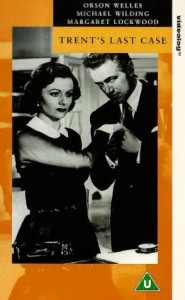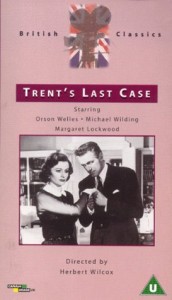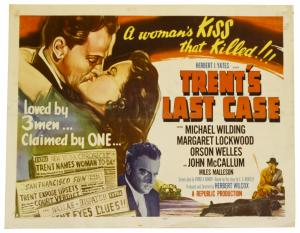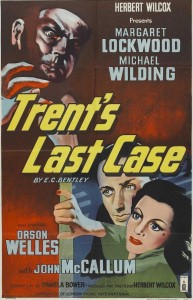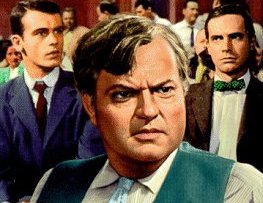Trent’s Last Case ***½ (1952, Michael Wilding, Margaret Lockwood, Orson Welles, John McCallum) Classic Movie Review 1675
Producer/director Herbert Wilcox’s involving and diverting 1952 British movie version of E C Bentley’s classic 1913 detective novel Trent’s Last Case is made efficiently and briskly, but in basic fashion and without much particular style or flair or hold on suspense. The film’s drawing-room tone is rather lighthearted for a murder mystery, but, even so, the film is likeable, engrossing and entertaining, and Wilcox takes the risk of filming dialogue-heavy scenes in long takes, which pays off nicely.
Trent’s Last Case is boosted enormously by a strong cast and especially the distinguished presence of Orson Welles, giving an energetic and magnetic performance in only a couple of scenes in flashback as the international business tycoon Sigsbee Manderson, who is found shot dead at his Hampshire mansion home. The London Record newspaper assigns its leading investigative reporter Philip Trent (Michael Wilding) to the case.
At the inquest, Philip Trent gets his first glimpse of the widow Mrs Manderson, and he starts drawing a portrait of her in court, a sure sign of his smouldering passion for her.
The police and the coroner think that the death is suicide but gentleman sleuth Trent quickly becomes convinced that Manderson has been murdered, perhaps by his secretary John Marlowe (John McCallum). When Trent gains entry to the Manderson mansion by posing as a relative, Marlowe throws him out, but he nips in through the French doors to confront the widow, who luckily is obviously not too adverse to him, flattered by his portrait drawing. And eventually, after lots of painstaking sleuthing, Trent is convinced that he has tracked down the killer.
Welles is of course typically hammy and splashy, making his mark in what is really no more than an extended cameo. He knows how to make it memorable, with a teasing build-up to his first appearance, in the style of The Third Man, a clipped, stagey delivery of his lines, and his actual appearance covered in weird make-up, with the bushiest of eyebrows and what looks like a false nose and stuffed cheeks, in the manner of Touch of Evil. Indeed this performance could be a dress rehearsal for Touch of Evil.
Michael Wilding has the main role, and it has to be said that he does it very well, with considerable sparkle and style, while John McCallum is excellent as the sweaty secretary who lusts after his boss’s wife. Margaret Lockwood is another asset playing another suspect, Manderson’s widow, Margaret, the part you rather expect to find Wilcox’s wife Dame Anna Neagle in – where on earth was she when she was needed? – though she does co-produce with her husband Wilcox. Lockwood is still a very handsome woman, though she looks older and harder than in her peak heyday, but that makes her ideal for her part. She is mysteriously alluring, and suggests why she is desired by three men. But is she the wicked lady?
The always entertaining Miles Malleson has an unusually large and satisfying role as tippling Burton Cupples, Margaret’s uncle and Trent’s friend, Jack McNaughton makes an impression as the sombre butler Mr Martin, and Sam Kydd enjoys a good role as Inspector Murch, the Irish detective leading the investigation, who believes the death is suicide.
[Spoiler alert] Writing on a dare, the British humourist and originator of the clerihew decided to satirise detective conventions. Bentley’s story is a milestone is detective fiction because not only does Trent fall in love with one of the primary suspects but also after painstakingly collecting all the evidence, he draws all the wrong conclusions and is told by the real perpetrator over dinner what mistakes in logical deduction he has made in trying to solve the case.
The title of what’s actually Trent’s first case is explained when Trent vows that he will never again attempt to dabble in crime detection after his humiliation this time. The film tweaks these situations slightly.
The movie marks Kenneth Williams’s film debut, aged 26, as Horace Evans, the Welsh junior gardener who finds the body at the start of the film. Also in the cast are Hugh McDermott, Jack McNaughton, Henry Edwards, Geoffrey Bayldon, Robert Cawdron, John Chandos, Anthony Collins, Henry Edwards, Ben Williams and Eileen Joyce.
The ever-unpleasant Raymond Chandler ridiculed points of the plot: ‘I have known relatively few international financiers, but I rather think the author of this novel has (if possible) known fewer.’
The book was adapted into a stage production by John Arden McClure, which premiered in January 2013. Time for a movie remake now?’
Lockwood and Welles re-teamed with Wilcox for Trouble in the Glen (1954).
Trent’s Last Case was popular but Lockwood’s next two films for Wilcox were weak at the box office: Laughing Anne (1953) and Trouble in the Glen (1954), ending their relationship. Wilcox later said their collaboration ‘did not come off’ but she was ‘a director’s joy who can shade a performance or a character with computer accuracy’. The thriller Cast a Dark Shadow (1955) with Dirk Bogarde was her last major film role.
Philip Trent reappeared in the novel Trent’s Own Case (1936) and the short-story collection Trent Intervenes (1938). An excerpt from the book is recited in Places in the Heart (1984) – the opening line: ‘Chapter 1. Bad News. Between what matters and what seems to matter, how shall the world we know judge wisely…’
It was also filmed in Britain as a silent movie with Clive Brook directed by Richard Garrick in 1920 and in America as a second silent adaptation by Howard Hawks in 1929. Forty years later, this presumed lost film turned up in cold storage in Alaska along with other old Fox films. In 1974 The Pacific Film Archive decided to include it in their special Howard Hawks retrospective. There was much excitement over a special viewing of an early lost Howard Hawks film never before seen in the US. Hawks called up the director, ‘You really aren’t going to play this are you?’
Hawks sat in the audience until he couldn’t take it any more. He walked up to the projection room and demanded that the projectionist destroy the film. But his demand could not be granted and his worst film is preserved for posterity.
A clerihew is a simple, humorous four-line verse, invented by Edmund Clerihew Bentley, containing two rhymed couplets and mentioning a famous person, such as: `The president is George W Bush, Who is happy to sit on his tush, While sending his armies to fight, For anything he thinks is right.’
Wilcox recalled in his memoirs that he paid Orson Welles £12,000 but because Welles was in debt he ended up with only £150.
Australian pianist Eileen Joyce is shown playing part of Mozart’s C minor Concerto, K. 491 at London’s Royal Opera House with an orchestra under Anthony Collins. Her playing of the second movement of Rachmaninoff’s 2nd Piano Concerto in Brief Encounter (1945) and The Seventh Veil (1945) helped to popularise it.
Lockwood said she adored working with Wilcox. She recalled working with Welles: ‘Orson is a genius and, like most geniuses in my experience, sometimes a trifle off. His oddity, or so it seemed to me while making this picture, was that he wanted to play his love scenes with me entirely by himself, without me. I must say they were very successful.’
The cast are Michael Wilding as Phillip Trent, Margaret Lockwood as Margaret Manderson, Orson Welles as Sigsbee Manderson, John McCallum as John Marlowe, Miles Malleson as Burton Cupples, Hugh McDermott as Calvin C Bunner, Jack McNaughton as the butler Mr Martin, Sam Kydd as Inspector Murch, Henry Edwards as Coroner, Geoffrey Bayldon as Reporter in court, Robert Cawdron as PC, John Chandos as Tim O’Reilly, Ben Williams as reporter Jimmy, and Kenneth Williams as junior gardener Horace Evans.
© Derek Winnert 2014 Classic Movie Review 1675
Check out more reviews on http://derekwinnert.com/


